- EPI's Specialties -
A brief presentation about our PRODUCTS and SERVICES
NOTE: All our Products, Designs, and Services are SUSTAINABLE, ORGANIC, GLUTEN-FREE, CONTAIN NO GMO's, and will not upset anyone's precious FEELINGS or delicate SENSIBILITIES.
EPI, Inc. provides a wide variety of capabilities for propulsion system analysis, design and development using high-tech analytical tools and measurement systems, and a wide range of engineering and manufacturing skills.
We specialize in the develpopment of High Performance Piston Engines and Drive Systems for Aircraft, Marine, Dynamometer and other Stationary Applications. Our Aircraft Propeller Reduction Gearboxes (PSRUs) have achieved unmatched in-flight reliability and renowned smoothness on high-powered V8 aircraft engines.
EPI has designed and developed various subsystems (Fuel, Ignition, Cooling, Lubrication, Engine Mount Structures, etc.) and accessory drives for piston and turbine aircraft, both for experimental and certified applications, as well as systems and components for Aircraft Engine Conversions. In addition, we have developed specialized dynamometer drive systems for one of the four NASCAR CUP engine company and for one of the two manufacturers of engines for the INDYCAR racing series.
COMMITMENT TO RESEARCH
EPI has an ongoing commitment to staying aware of and informed about the special challenges faced by our clients. The following video (click on the picture below) shows a summary of 61-lap test at Charlotte Motor Speedway that demonstrates our commitment and the relentless levels of our research.

The test shown in this video proves beyond any doubt that a race car with an underpowered engine and the wrong gearing cannot possibly be fast, regardless of how good the chassis setup is, and regardless of how good the driver is.
It is most likely that our NASCAR clients were already well aware of that conclusion, so nothing new was discovered.
PRODUCTS
|
We develop high performance engines for Aircraft, Automotive, Marine and Industrial Applications. Before we closed our manufacturing branch, we had produced extremely reliable aircraft-quality PSRU gearboxes for various custom applications, including the Mark 9, the Mark 15, the Mark-25, and the Mark-27. |
|
The engine pictured here is a clean-sheet, air-cooled aircraft engine designed to be an improved replacement for the Continental O-200. The O-200 claimed 100 HP but in reality never made more than 95 on its best day. This new engine made 126 honest HP on its first full-power dyno run. More information on this engine can be seen HERE. |
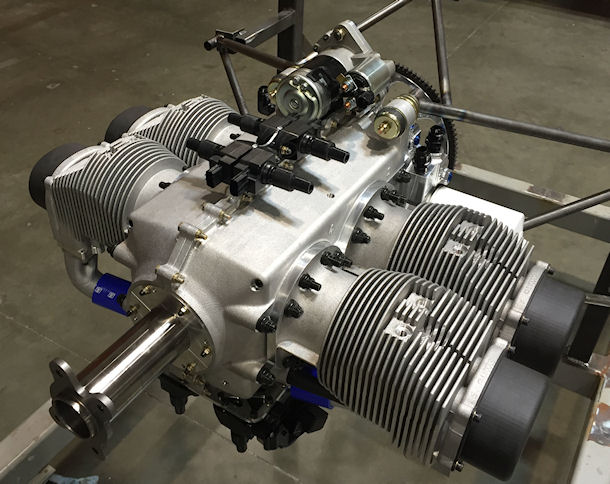
|
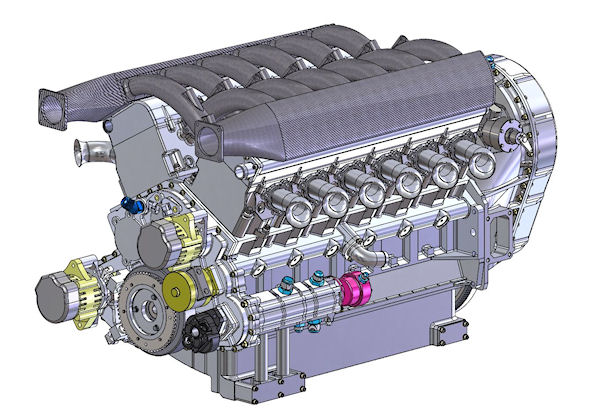
|
The engine pictured at the left is a 3D-CAD graphic showing one view of our clean-sheet, 60°, 650 CI V12 engine. |
|
The engine pictured to the right is our Gen-1 Aircraft V8 (from the late 1990's) which produced over 500 HP at 4600 RPM, and was capable of extended 450 HP cruise operation at 4000 RPM (No longer available because better, modern engine architectures are more suitable). Our Gen-2 Aircraft V8 products were based on the GM fourth-generation "LS" engine architecture. We had been working (in "spare time") on a lightweight, high-power, compression-ignition V8 engine designed to operate on Jet-A and Jet-A1 fuel. It was progressing well until the client who was funding the development ran afoul of financial difficulties. That was probably just as well, because the EPS Compression Ignition Engine turned out to be a magnificent work of art and engineering. |
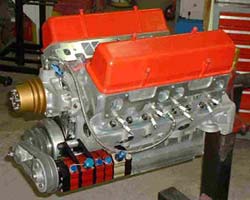
|
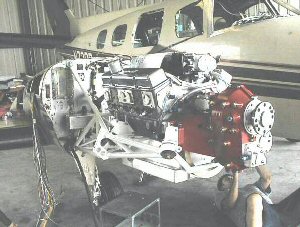
|
We have designed several high-capacity, high-reliabilty transmissions for various applications including Propeller Reduction Gearboxes , helicopter gearboxes, dynamometer applications and industrial turbine applications. The gearbox pictured to the left is an EPI Mark-9 gearbox on a V8 conversion of a Beech Duke, which was an extremely high performance aircraft when finished. The Mark-9 was used very successfully on the GP-5 Reno Racer., and was also an integral component of the EngineAir 450-HP turbocharged V8 powerplant used on more than 25 LancAir-4P aircraft. Our most-recent large PSRU is the very refined Mark-15, that can accommodate input torque values in excess of 1600 lb-ft. Another recent transmission system is the Mark-25, which is a complete power transmission system for a new turbine helicopter, and the Mark-27, a PSRU for high-performance VW engine systems. |
|
As a part of our powerplant packages, we design Engine Subsystems and Accessory Drives.
Shown here is the accessory system we designed and built for our GM-572-based cropduster conversion. It provides a redundant, separated-belt coolant pump drive, an air-conditioning compressor (essential for cropdusters), and a high capacity alternator, with independent tensioners for each belt.
We also designed and prototyped a Standby Alternator Drive for the TPE-331 in a certified application. |
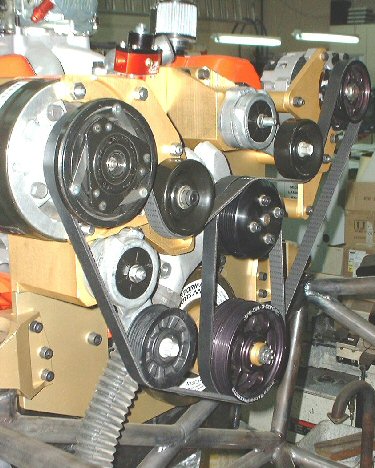
|
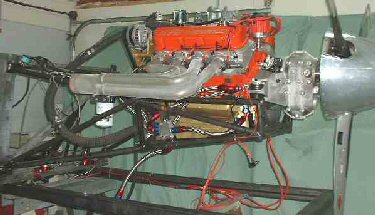 |
We design (and previously manu-factured) prototype Aircraft Engine Conversions and Mounts. The mounting systems are designed to meet the conservative load requirements of FAR Part-23. |
SERVICES
DESIGN and ANALYSIS
Effective, reliable designs depend on accurate analysis of all the parameters which define the operation and interfaces of a system. We use sophisticated design and analysis tools to produce effective designs quickly.
We begin by analyzing the requirements of a system with basic engineering procedures. We use hand calculations, purchased software (such as our Computational Fluid Dynamics package for aerodynamic bodies and passages), our Piston Engine Simulation package, the results of which typically match dyno test results w ithin 3-5%), as well as software designed and developed in-house for the analysis of vibration and resonance, dynamic loading in geared systems, spline loadings, flight loads, and many other specialized areas.
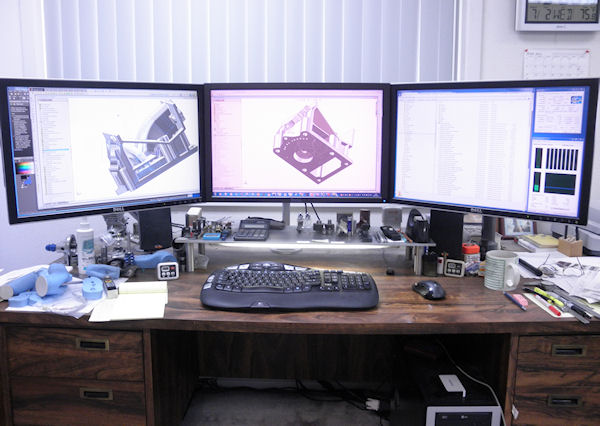
Using constraints and requirements developed from preliminary analysis, we design components, assemblies and systems using powerful 3D-CAD modeling software (SOLIDWORKS™), followed by detailed Finite Element Analysis (COSMOS™) to determine the stresses and strains components will endure under the expected loadings. This cycle is repeated until a suitable level of performance and reliability can be predicted from the analysis.
We also provide top-grade 3D-CAD modelling, Finite Element Analysis of components, Engineering Drawings, and Technical Writing services for clients. We guarantee complete confidentiality of client data, products and ideas.
ENGINE PERFORMANCE IMPROVEMENT
EPI has years of successful experience in High Performance Engine Development. We use our in-house analysis and testing equipment to develop cylinder heads, manifolds, valvetrain systems, lubrication systems, and accessory systems.
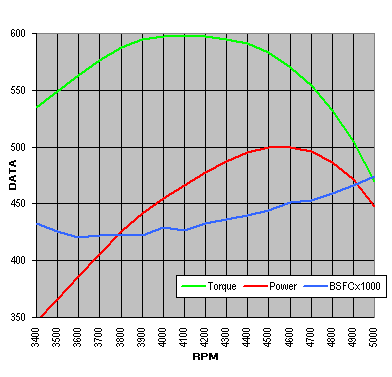
Our engine improvement programs usually produce quick results because they are based on research using sophisticated, unsteady-flow analysis Engine Simulation Software, which reveals the paths and strategies which will produce the desired power and torque characteristics.
Our Simulation Package uses the properties of the actual engine components (measured port and manifold airflow data, measured cam lobe data, measured valvetrain mass and deflection properties, reciprocating component masses and geometries, etc.) to predict the performance of a specific configuration. DYNO-testing verifies the performance and reliability of the configuration. Software predictions of engine performance often correlate to dyno measurements within 3 percent, and rarely deviate from dyno results by more than 5%. (Larger deviations are almost always the result of bad data in the simulation.)
AIRFLOW DEVELOPMENT and EVALUATION
EPI provides comprehensive development services for cylinder heads, manifolds, and general airflow improvements.
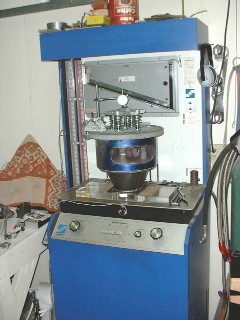
New EPI Head for 5000 HP Diesel
We offer improvements in the flow level and flow quality for ports and combustion-chambers, detailed measurements of volume-flow vs. valve lift, port velocity-profile mapping, measurement of in-cylinder charge swirl, and mapping and improvement of boundary layer separation, especially on port floors and short-turn radii.
We use a SuperFlow SF-600 Airflow Measurement System with an integrated, fully-computerized Audie Technology Data Acquisition System. Those systems together provide highly repeatable measurements and recording of bidirectional volume-flow, cross-sectional velocity profiles, and charge swirl. The data acquisition software provides comprehensive graphical and textual report formats.
Our cylinder head development clients include a respected NASCAR Engine Builder and a prominent Industrial Engine Manufacturer.
Pictured here is a new cylinder head we developed for the GM 645 (Electro-Motive) two-stroke diesel engine (645 cubic inches per cylinder). With the standard GM heads, the 8-cylinder version of the engine produces 1525 HP at 900 RPM. With the EPI heads, the 8-cylinder engine exceeded the dyno capacity (2000 HP) before reaching "full rack". With these heads, the 20-cylinder version (3800 HP) is expected to approach 5000 HP at 900 RPM.
VALVE TRAIN EVALUATION and DEVELOPMENT
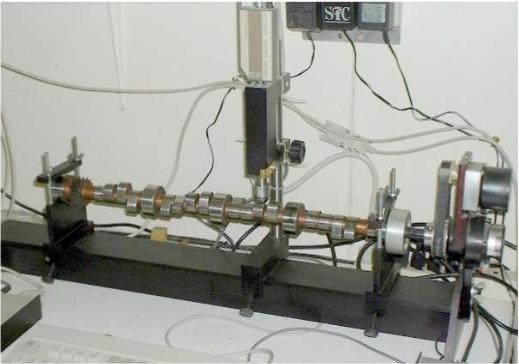
An essential component of our engine development toolset is the ability to do detailed analysis and evaluation of valvetrain systems and components.
Pictured here is our Audie Technology computer-controlled Camshaft Lobe Measurement System (CamPro-Plus™). It automatically measures cam lobe lift profiles every 1/10th degree of rotation with one micron (0.00004") lift resolution.
The CamPro-Plus control software numerically differentiates the lift profiles to determine velocity, acceleration and jerk characteristics. It also provides detailed reports and graphical plots of the various curves.
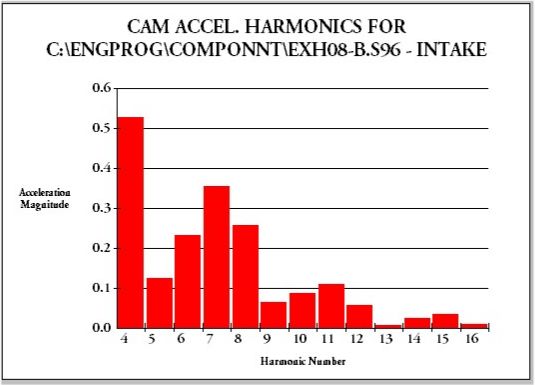
Harmonic Content of a Lobe Acceleration Profile
Valvetrain analysis doesn't stop with the camshaft. The entire valvetrain must be treated as a complex vibration system being driven by the cam lobes.
As such, it is essential to know the harmonic excitation properties of the cam lobes.
Our (purchased) Fourier analysis software determines the harmonic excitation content of cam lobes we have measured.
In order to analyze a valvetrain system, we use various methods including our precision measurement tools, our 3D-Cad and FEA systems, to determine the mass, stiffness and resonant frequency of valves, valve springs, retainers, pushrods, rocker arms, and cam followers.
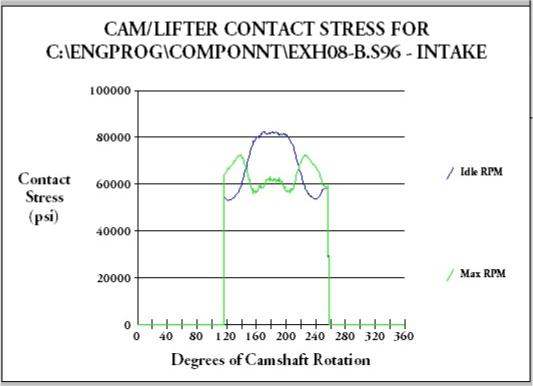
Valvetrain Dynamic Stress Levels
Using another piece of EPI-developed test equipment which measures the moments of inertia of components about a given axis, we can determine the mass moment of inertia of rocker arms and finger followers.
That information enables us to do a thorough analysis of a valvetrain, to optimize components (springs, followers, pushrods, rockers, valvesprings, retainers, etc.) to avoid resonance points which coincide with high orders of cam lobe excitation, and to operate at stress levels necessary to provide the required degree of reliability.
COMPLETE ENGINE TESTING and DEVELOPMENT
Without a reliable method to test the results of an engine program, the product is no more than conjecture, guesswork and maybe some marketing hype thrown in for good measure. We use two different dyno facilities to test our work: (a) A standard Super Flow 901 computer-controlled waterbrake dynamometer, and (b) An EPI-designed and developed propeller dyno.
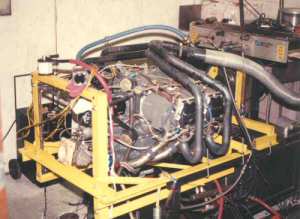
|
This picture shows one of our modified Lycoming aircraft engines on the SuperFlow 901 dyno. In the factory configuration, this engine allegedly produces 200 HP at 2700 RPM (but not really). The testing program helped identify the most effective modifications, which ultimately produced 226 HP at 2700 RPM (a BMEP exceeding 184 psi). That is an increase of 13% over the official "rated" power of that engine. |
|
This picture shows an endurance test on a modified Lycoming aircraft angine. Our Propeller Dyno uses a propeller to both load the engine and to provide cooling airflow. The dyno has a computerized data acquisition system which measures torque and RPM, from which Horsepower is calculated. That is the same method as is used by other major dyno systems (SuperFlow, DTS, Stuska, AVL and others). NOTE: This dyno DOES NOT estimate power from a measurement of propeller thrust., as claimed in one popular book on engine testing. |
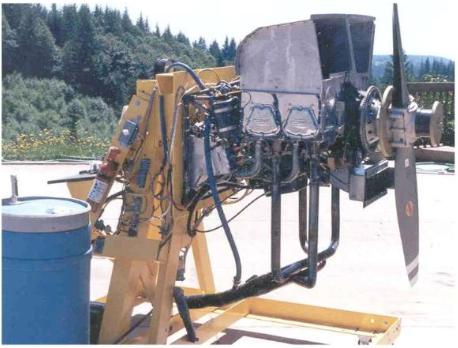
|
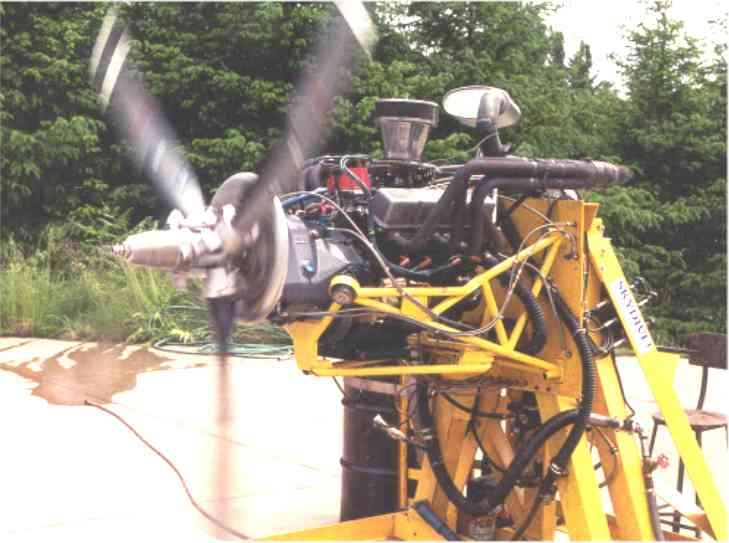
|
This picture shows our Propeller Dyno with a 400 HP "Mule"V8 engine testing a new Mark-9 Propeller Reduction Gearbox (PSRU) prior to shipment |

